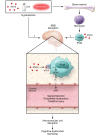Macrophages come to mind as keys to cognitive decline
- PMID: 27841765
- PMCID: PMC5127658
- DOI: 10.1172/JCI91277
Macrophages come to mind as keys to cognitive decline
Abstract
Cognitive impairment, an underappreciated consequence of hypertension, is linked to cerebral arteriolar disease through poorly defined mechanisms. A study by Faraco et al. in this issue of the JCI points to perturbations of neurovascular unit coupling caused by perivascular macrophages (PVMs) as a cause of hypertension-related cognitive impairment. Angiotensin II (Ang II) was shown to activate PVMs, causing them to produce superoxide and thereby alter the proper functioning of the adjacent arterioles. Faraco and colleagues also show that disruption of the blood-brain barrier occurs in hypertension, allowing circulating Ang II to access PVMs. This study provides important new insight into the role of inflammatory cells in the genesis of vascular dementia.
Conflict of interest statement
The authors have declared that no conflict of interest exists.
Figures

Comment on
-
Perivascular macrophages mediate the neurovascular and cognitive dysfunction associated with hypertension.J Clin Invest. 2016 Dec 1;126(12):4674-4689. doi: 10.1172/JCI86950. Epub 2016 Nov 14. J Clin Invest. 2016. PMID: 27841763 Free PMC article.
References
-
- Launer LJ, Masaki K, Petrovitch H, Foley D, Havlik RJ. The association between midlife blood pressure levels and late-life cognitive function. The Honolulu-Asia Aging Study. JAMA. 1995;274(23):1846–1851. - PubMed
Publication types
MeSH terms
Substances
Grants and funding
LinkOut - more resources
Full Text Sources
Other Literature Sources
Miscellaneous

